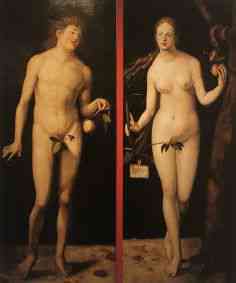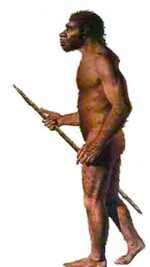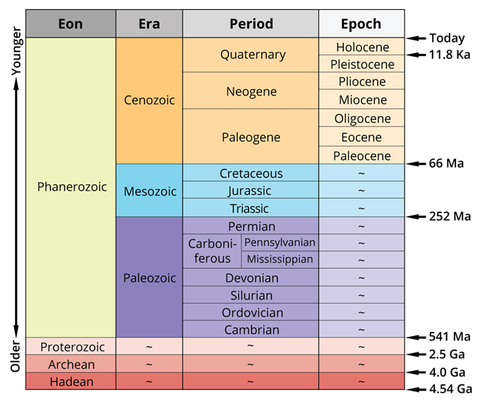 Home
Actueel
Visie
De 7 fasen
De Esoterische Evolutie
Boeken
Artikelen
Verwante teksten
Tegenkrachten
Over Margarete
Quotes / Test
Links / contact
Home
Actueel
Visie
De 7 fasen
De Esoterische Evolutie
Boeken
Artikelen
Verwante teksten
Tegenkrachten
Over Margarete
Quotes / Test
Links / contact
|
Esoteric Evolution - 15The Human Being in ParadiseIn the Bible, Paradise is mentioned for the first time in Genesis 2:8. It follows directly after Genesis 2:7 where we are told that the Lord God formed the human being out of dust of the earth, breathed the breath of life into him, and that the human being thus became a living being. The earlier, six-day, creation process described in Genesis 1 was then already completed. The situation in Paradise therefore takes place after the six-day work and after what is called the second creation process in Genesis 2:7. The two previous chapters show that during the second creation by Yahweh-Elohim the I was dripped bit by bit into the different bodies of the becoming human being, the astral body, the etheric body, and the physical body. By this I a connection came about between corporeality and spirit, the higher spiritual Self. The higher spiritual Self forms part of the divine Holy Spirit that emanates from Christ, God the Son. It forms the deepest core of us humans, the divine spark in our inner being. The addition of the I - a gift from the Elohim, the high Spirits of Form from the second hierarchy - marks the actual beginning of true humanness on the earth. It is in this early stage of human development, right after the descent of the I, that the Bible speaks about the human being in Paradise. ParadiseGenesis 2:8 describes Paradise as follows: "And the Lord God planted a garden in Eden, in the east; and there He put the man whom He had formed." For the first time, we have a concrete encounter with the human being. We can see him in front of us, as it were. It may strike us, however, that the author of Genesis does not use the names Adam and Eve, but the general term human being. We can understand that when we realize that at that stage there were not yet a man and a woman, but a male-female being that was androgenous, male-female in one. Hence the statement in Genesis 1:27: "male and female He created him."
The Garden of Eden, where the human being then lived, is described as a delightful place, a paradisal situation where the human being lived close to God and therefore in the golden glory, bond, and harmony of the divine world. In the middle of this delightful garden the Lord God had planted two special trees, the tree of life, bearer of the life forces, and the tree of the knowledge of good and evil. However, He told the human being: "You may freely eat of every tree of the garden; but of the tree of the knowledge of good and evil you shall not eat, for in the day that you eat of it you shall die." Genesis 2:21 tells us that God created a woman out of the human being. In Genesis 3 she gets the name Eve. In that chapter we also meet the serpent, the craftiest of the all the animals that God created. The serpent seduced first the woman and then the man to eat the fruits of the tree of the knowledge of good and evil by saying: "You will not die. For God knows that when you eat of it your eyes will be opened, and you will be like God, knowing good and evil." Attracted by the prospect of becoming intelligent and wise, the woman, Eve, plucked some of the fruit, ate some and gave some to her man. Thereupon the Lord God sent the human being away out of Paradise, the Garden of Eden, in order, as Genesis 3:23 says: "… to till the ground from which he was taken." After He had driven him out, God "placed the Cherubim, and a flaming sword which turned every way, to guard the way to the tree of life." (Genesis 3:24) Thus did the human being leave Paradise and enter into the hard earthly world. The human being in ParadiseHow should we picture the human being in that paradisal condition before the expulsion? What did he look like? In the sixteenth century, artists like Albrecht Drer painted Adam and Eve with beautifully formed bodies. But does that correspond with reality? To answer that question we first have to give the events that happened in Paradise a place in human evolution. The second creation and the paradisal condition can be found in the period about halfway through Lemuria. The development of the earth
In our time we are in the fifth era, the post-Atlantean era, and within it in the fifth sub-period, also called the fifth cultural epoch. According to Rudolf Steiner, the corporeality of the human being received a form that corresponds with the current form of our body only at the end of Atlantis. According to conventional science the human being grew into his current form as a result of an evolutionary process that is schematically represented as follows:
Life begins with single-cell organisms and ends step by step with the human being as he is today. Rudolf Steiner and the theory of evolution of DarwinFor us it is interesting that Rudolf Steiner also uses this schematic to convey his views of human evolution. He did this after he had extensively studied the work of Ernst Haeckel (1834-1919). Haeckel was a German zoologist and philosopher who made the works of Charles Darwin widely known in German-speaking countries. Rudolf Steiner concluded that the facts are right, but the explanation of them given by Darwinists is not. The (Neo-)Darwinists assume that the whole evolutionary process from single-cell organisms all the way to human beings is a coincidental process that just arose somewhere as a result of accidental variations because of unexpected mutations and natural selection. By means of natural selection, new species formed themselves out of the single-cell organisms, then again new species grew, until ultimately via the apes human beings appeared. This representation led to the still common view that the human being is descended from the apes, and is therefore a higher animal. (Neo-)Darwinism strongly emphasizes that evolution has no goal, does not aim for anything, and is not intended by a god or any other spiritual being. The human being is but the accidental result of a play of necessity and coincidence, and might just as well not have come about. Whoever looks for a higher intention behind evolution is, they say, thinking unscientifically and is a dreamer. For Rudolf Steiner the insights of Haeckel and Darwin were reason to start a profound spiritual-scientific investigation into the evolution from single-cell organisms to the human being. That research led him to very different interpretations of the facts. The results of this research were published in his book An Outline of Esoteric Science, as well as in many lectures. Based on the facts, his explanation says in brief that long before the single-cell organisms appeared, the human being existed already as a spiritual being. That was in the far, far distant past in a different, spiritual reality, a reality that preceded earth existence. This means that the human being is older than all other living creatures on the earth. The creation as a separation processAll life forms or organisms that would ever appear on the earth, he said, were in that far distant past part of one all-encompassing spiritual world-being. In order to adopt our current physical form - which we need to fulfill our task as human beings on earth - human beings had to gradually free themselves, spiritually as well as physically, from this all-encompassing envelopment of the spiritual world. This happened during the great developmental process that is described as the evolutionary process of life on earth. During this gigantic evolutionary process, the Elohim step by step separated out of this all-encompassing spiritual being the organisms, the species that in the course of long periods of time appeared as singe-cell organisms, fishes, reptiles, mammals, apes, early humans, etc. Human beings as they are today only came into being after the apes and early humans had freed themselves out of this world being and had become autonomous. What freed itself next was today's human being, homo sapiens sapiens, the human being we are now. Evolving corporealityThe Elohim accomplished this eons-long creative process by developing an evolving corporeality, from which ultimately today's physical appearance of the human being emerged, a human body that is suited to be the bearer as well as interpreter of the divine spirit on earth. For that purpose, the Elohim continually removed certain aspects from the original spiritual form. Through extensive processes, these separations then received their own forms. Through separation in this way of the "plant-like" out of the becoming corporeality the human being, the great diversity of plants and trees arose in the course of evolution. Similarly, the "animal-like" was driven step by step out of the original form, and the Elohim gradually created the physical forms as they were described above, the single-cell organisms, the fishes, the reptiles, the mammals, the apes, and the early humans, until the current human body came into being. This indicates, says Rudolf Steiner, that the human being is not descended from the animals, but that the animals came into being out of the becoming, evolving human corporeality. That is a completely different picture. Although in their evolutionary process that lasted many millions of years, becoming human beings did go through different stages that correspond with different species in the animal kingdom, they were never actually animals, nor did they descend from them. From the beginning they had their own goal and significance. With his esoteric view of evolution, which was developed out of spiritual insights, Rudolf Steiner offered an alternative to the limited views of (Neo-)Darwinist materialism. In his vision, the human being is the beginning and the end, the origin and the goal of the creation. The task of human beings is to become free and self-aware individuals who fully develop the wisdom and power of love of their spiritual core, the divine spark in their own inner being. By making that a reality, human beings raise themselves in a new, conscious way, back to the spiritual world and thus to a higher level of existence. A different look at the phenomena
Several of Rudolf Steiner's pupils, who are both natural scientists and anthroposophists, are showing in their work that the esoteric view of evolution can be seen everywhere, in the anatomy of the bodies of plants, animals, and humans, but also in fossil forms of formerly living beings. The point is, they say, to learn to look at existing phenomena in a different way. Over time, the different forms show a continual and consistent, ever rising development via countless metamorphoses, which ultimately result in the form of the human being. This can be seen in the skeleton, but also in the structure and function of the inner organs. New organs first appear externally and then turn more and more inward - a tendency that can be traced through the whole history of the earth. In evolution there is an undeniable focus on goal and purpose. The foregoing, the comparison between the (Neo-)Darwinist and the esoteric view of evolution, was needed to show that, regarding the human being in Paradise, both views come to the same conclusion. The conclusion is that in Paradise human beings did not yet possess beautiful, perfect human bodies. What artists like Albrecht Drer want to make us believe thus did not yet exist at that time - it did in their invisible spiritual form, but not yet in the physical-material. The story about Paradise therefore is of an allegorical nature. It expresses in a symbolic way what at that time occurred in human development. In reality, the bodies of the becoming human beings, into which Yahweh-Elohim was slowly adding the I during Lemuria, still had a clearly animal-like form. The evolutionary periods of the earth and the geological time schemeAccording to Rudolf Steiner, in the geological time scheme, Lemuria was approximately the time of the Mesozoic Era, which lasted from 225 million to 65 million years ago. In about the middle of this period human bodies still had an air-and-water character, in which something like a jelly-like densification was already occurring, like in the bodies of later jellyfish and slugs. In the course of Lemuria, those bodies changed form, became "fish-like," and even later "amphibian-like." That happened because at the time the original forms of mollusks, fishes and amphibians had not yet been separated out of the becoming human corporeality. This only happened during that process. Later again, the crawling animals and lower mammals came into being as separations. During Atlantis, as a result of a leap in evolution, the first forms of the higher mammals suddenly emerged. According to Rudolf Steiner, Atlantis largely corresponds with what in geology is called the Tertiary period followed by the Pleistocene epoch, a time period that in total lasted from about 65 million to about 10,000 years ago. During Atlantis, the human body went through forms comparable to those of the higher mammals, notably those of apes. These already showed, although outwardly still in animal-like forms, some more human characteristics. That was even more the case with what we know as "early human beings," such as the Neanderthal. The Neanderthal was a stage between apes and the later humans. In the course of time, they died out.
Only when these early human forms had been separated out, says Rudolf Seiner, in post-Atlantean time after the ice age, at the beginning of Holocene, human beings came into existence in their current form homo sapiens. Around 10,000 years ago post-Atlantean times began, which will last to the year 7893 AD. It will be followed by the great, sixth era, during which entirely new circumstances will reign on earth. The body of the human being, homo sapiens, further developed in the post-Atlantean period and reached its perfection in Greek-Roman times. More about the condition and events in Paradise in the next chapter. SourcesRudolf Steiner, An Outline of Esoteric Science, GA 13. Jos Verhulst, Developmental Dynamics in Humans and Other Primates: Discovering Evolutionary Principles through Comparative Morphology, Kindle edition. Dankmar Bosse, The Mutual Evolution of Earth and Humanity, SteinerBooks. © Margarete van den Brink 2007-2025 - www.margaretevandenbrink.nl
|
||||||||||||||||||||||||||||||||||||||||||||||||||||||||||||||||||||||||||||||||||||||||||||||||||||||||||||||||||||||||||||||||



 Adam and Eve : Albrecht Dürer 1507
Adam and Eve : Albrecht Dürer 1507




